March 30, 2022 – Volume 24, Issue 3
In This Issue
- Flanigan’s Eco-Logic: Civic Duty
- 24/7 CFE Carbon-Free Accounting
- Mega Hydrogen Projects
- Hydrogen Combustion NOx
- SunCable to Singapore
- Flow Batteries from Australia
- End of Life Solar Modules
- New Life for Turkish Coal Mines
- Pumped Hydro Storage
- The Empire State Leads in Community Solar
- The NetPositive Podcast Updates
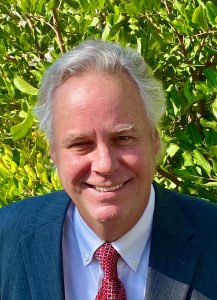
Flanigan’s Eco-Logic: Civic Duty
Nearly two years ago I was honored to be asked by Glendale City Council Member Dan Brotman to serve as a Commissioner for Glendale Water and Power, our hometown municipal utility. Glendale has some 210,000 residents and its own utility which peaks out at about 350 MW of power. We deliver about 25,000 acre feet of water each year, nearly 8 billion gallons. This results in combined gross revenues of ~$300 million.
Within a few months, I was elected by my fellow commissioners to be president. To the best of my abilities, my job has been to guide the Glendale Water and Power Commission and to work to clearly articulate our advice to the city council members for whom we serve.
Two hugely controversial issues have been on our docket: First, whether or not to recommend approval of a landfill methane power plant. While not large, 12 MW max, it would burn methane/biogas from the Scholl Canyon Landfill. Like it or not, we have methane there for decades to come – poor quality and degrading all the time. The landfill was one of the first in the nation to install a methane collection system. The gas was piped and burned at the Grayson Power Plant, seven miles away. But the caustic gas damaged the turbines and raised local air pollution problems that ended its use there. Since then, the methane has been flared at the landfill.
The decision came down to this… either continue to flare it or burn it in highly efficient engines providing 12 MW of renewable power and tens of millions of dollars of value to the City. Not trusting the safety of the generation, the local neighborhoods wanted to continue to flare it. They still do.
After visiting the site, considering the pros and cons, speaking directly to homeowners there, weighing considerable environmental analysis, I recommended getting some useful value from this nasty fuel. What’s best for our community? Given the fact that the gas is there, given the efficiency of the units and the dispersion rates from this hilltop landfill, the benefit outweighs the impact. So yes, build modular generating units with the best available control technologies. Trade-offs, upset citizens. Tough cases… that’s civic duty. You’ve got to make a decision.

The second major issue that we faced this year was even more contentious: Whether or not to build 93 MW of natural gas fired capacity at the Grayson Power Plant. Let’s back up. Grayson is a sprawling facility of 9 generating units located along the Los Angeles River in Glendale. One of the boilers was built in the 1940s, another in the 1950s. It’s a museum. Right now you may be able fire up as much as 160 MW there. Several years ago, GWP wanted to increase the plant size to 262 MW using combined-cycle gas turbines. That plan gave rise to the Glendale Environmental Coalition (GEC) headed up by Dan Brotman. GEC members could not see why the utility would invest in gas-fired capacity – a 30 – 40 year asset… when our society – and our utilities – are making large and needed strides to decarbonize. GEC’s message was loud and clear.
GEC got the public and Council’s attention, and Council put the 262 MW re-powering project on hold and instructed its utility to release an open solicitation called the Clean Energy RFP. Over 40 proposals presented solutions for the City… things like virtual power plants, solar everywhere, energy efficiency, demand response. Several programs took root, others are still in development, and at the end of the day, the utility came up with a revised re-powering scheme for Grayson. Gone is 262 MW of baseload capacity. The revised plan calls for 93 MW from five, 18 MW Wartsila engines that will run no more than 15% of the time, and 75 MW of Tesla batteries. Wartsila, a Finnish company, is developing means to use higher and higher concentrations of hydrogen fuels in these engines.

Ted Flanigan, Sarojini Lall, Mayor Paula Devine, and Joel Peterson at Glendale’s State of the City Luncheon
My commissioners and I have studied the facts, deliberated, we’ve been lobbied, and in the end, we were united in consensus. Let’s get off gas as soon as possible. Let’s encourage policy to convert the gas engines to green hydrogen as soon as possible. Let’s maximize energy efficiency and demand response in the City. Let’s fully support distributed energy resources. And, let’s build this scaled-down power plant so that our utility has sufficient capacity in the summer months in the coming years. Rather than being short and putting the community at risk of rolling black-outs, let’s put the capacity in place to safeguard our seniors, our hospitals, our vital infrastructure, and our community. While not perfect as it does involve gas use, the Commission and I saw the good in the revised plan. Accept it with the caveats above. That was our recommendation to Council.
Shortly thereafter, Council took up the Grayson re-powering issue. Dan Brotman had gone from GEC founder to City Council member. He wants to leave no rock unturned and to continue to dig into alternatives to the plant. GWP buys most of our power from far away and access is constrained, complex, and historically rooted. Can GWP negotiate for greater transmission access from LADWP? Can GWP buy more capacity from LADWP? Can GWP ramp up energy efficiency and demand response programs? How much distributed solar and storage can be readily built in the City. Dan Brotman presented a motion to postpone the decision to fully explore these carbon-free options.
The motion to dig deeper for alternatives passed. All five units that make up the 93 MW plant are now on hold as solutions are considered. Time is of the essence as air quality regulations are forcing the closure of some of Grayson’s units. Hopefully the benefit of the delay, finding means to be deep green and true to a carbon-free future, will be greater than its cost. It was a risk that I was not willing to take and impose on those vulnerable in our community.
Coming down on the side of combusting fuels is uncomfortable for me. EcoMotion specializes in solar and storage solutions. My career has been dedicated to greening through efficiency. But civic duty caused me to think broadly, not just about my positions, but the livelihoods of the many residents of our community. I’m in a position of influence, and my charge is to use that for the greater good. Not my dogma, but the greater good. I studied these issues, considered and reconsidered, and at the end of the day, had to make a judgment. Actually two. One in favor of using nuisance gas for community benefit, and the other for the strategic deployment of 93 MW of gas-fired capacity. What a year. What a year of tough decisions. Baptism by fire in the name of civic duty.
Quote of the Week
“Reaching this nation-leading milestone — with more than one gigawatt of community solar installed — is a testament to New York’s aggressive pursuit of clean-energy alternatives that will surper-charge our economy and bring us one step closer to a carbon-neutral future.”
New York Governor Kathy Hochul
24/7 CFE Carbon-Free Accounting

Being “net zero” power consumers isn’t enough. That “net” has implications… often involving carbon. Sure, I get credit for all the green power that my solar system generates. But at night, I may well be drawing kilowatt-hours from coal or nuclear or gas sources. “That ain’t good.”
Leading companies – like Google and Microsoft and IBM – are focused on what some call a seemingly impossible frontier, figuring out how in real time to match energy use with clean energy supply. How can they ensure that there is clean energy available where and when it’s needed all day, every day? That’s the challenge. There have been and still are times when there is not enough solar or wind available… and “carbonated electricity” has still been drawn and used.
Google was early in articulating its 24/7 Carbon-Free Energy goal. Microsoft has a 100% plan. IBM calls it “true zero.” But how to get there? How to get 24/7 CFE? Largely, this will be accomplished by coupling diverse renewable resources that have different generation profiles. Take solar when the sun shines; mix offshore and coastal and intercontinental wind resources; tap geothermal and hydro resources. The wind blows at night, and in the shoulder hours of the sunlit day. Pairing load profiles of different renewables also is seasonal, so it has to be strategic, predicting weather, etc. It also involves shifting consumption load profiles with “carbon-aware” software and long duration energy storage.
The excitement, or what some have called hype, about green hydrogen is closely linked and supportive of the CFE stretch goal, or what used to be stretch goal. Now it’s a clear direction. We’ll need to store green power. Electrolyzing water is one way to do it, converting renewable power to a green fuel. And that fuel has many uses, primary among which is storage. A basic use is onsite storage to fulfill local or facility 24/7 CFE goals: Generate electricity with solar or wind, electrolyze water to create green hydrogen, store the hydrogen, and then run through a fuel cell during those periods when the renewable resources are short. Losses? Of course. Buy cheap power and use storage judiciously.
Microsoft has committed to powering all of its buildings and data centers with CFE by 2025. In Sweden, it has a contract in place with Vattenfall to power three of its data centers with clean energy… hydro in that case. Google and Microsoft data centers in Virginia will be supplied with round the clock renewable energy. JP Morgan Chase plans to run all of its offices in the United Kingdom with clean energy all day, thanks to a partnership with EDF and ClearTrace.
Mega Hydrogen Projects
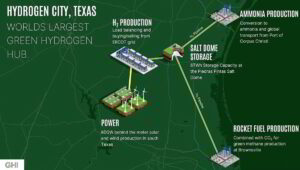
Saudi Arabia intends to be the world’s biggest exporter of hydrogen. Currently Aramco, the Saudi state-owned oil company, is making blue hydrogen by stripping hydrogen off natural gas and then sequestering the remaining carbon. Now the country has a bold plan to rule the $700 billion hydrogen market. The plan includes a massive green hydrogen project called “Helios.” It will use 4 GW of wind and solar to power 120 Thyseenkrupp AG Electrolyzers that are each 130 feet long to generate green hydrogen. Saudi Arabia plans to ship the hydrogen fuel as ammonia as it is easier to transport.
Texas is not to be outdone. There, a 60 GW green hydrogen project called Hydrogen City is in the works. It is slated to be the largest green hydrogen hub in the world. It will use wind and solar drawn from the ERCOT grid during periods of low prices to generate 2.5 billion kilograms of hydrogen per year. The facility will utilize its own salt cavern for storage. The hydrogen will be piped to port cities for different applications from green ammonia, to sustainable aviation fuel, and other green fuel products.
German RWE and London-based Neptune Energy have signed a development agreement for an offshore green hydrogen demonstration project to be built in 2023. H2OpZee aims to build as much as 500 MW of electrolyzer capacity in the Dutch North Sea to produce green hydrogen by using offshore wind. The green hydrogen will be carried to land in existing pipelines.
Meanwhile, the Dutch data center company, NorthC, reports that its Groningen facility will install a 500 kW hydrogen fuel cell module that will run on green hydrogen. It will be the first data center in Europe to have done so.
Hydrogen Combustion NOx
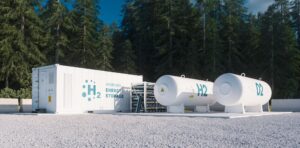
Green hydrogen has been taking a bit of a hit in the press recently. Why? Turns out that when you combust green hydrogen, it isn’t just water vapor that is released. Combustion of hydrogen can lead to the thermal formation of nitrogen oxides (NOx, the sum of NO and NO2). The combined formation process is referred to as thermal NO, or the “Zel’dowich Mechanism.” It occurs in all fuel – air mixed flames hotter than 1,300 degrees C. The high temperature flames produce nitrogen oxide by drawing nitrogen into the process from the surrounding air.
Some reports suggest that burning hydrogen might result in higher levels of nitrogen oxide gasses than burning natural gas. Other reports suggest that the amount is about the same. But note that the cleanest and preferred use of green hydrogen is not for combustion, but to use it to power fuel cells electrochemically. There is no combustion involved with fuel cells, and thus no nitrogen oxide is released. Another clearly beneficial application is using hydrogen fuel to replace diesel in heavy trucks. In that use case there is combustion, and NOx results, but there is a clear and pronounced net benefit.
But let’s get back to powering power plants with hydrogen. Gas turbines today employ “Dry Low NOx” (DLN) combustion systems designed to limit NOx. Currently, these gas turbines can only operate with a blend of up to 15% hydrogen, although there have been successful tests at 50%. Going to higher and higher hydrogen blends – and to 100% – will require upgraded systems to minimize and capture NOx.
SunCable to Singapore

Australian billionaires – Mike Cannon-Brookes and Andrew Forrest… are big-time investors in renewables. Their plan reflects massive scale… bringing solar power from Australia to Singapore via an undersea cable link known as the Australia – Asia PowerLink (AA PowerLink). The power lines will be 2,600 miles long, the longest high voltage direct current undersea transmission line in the world.
The company SunCable is building a solar farm in the deserts of the northern territory region in Australia. It will supply power to the Tasmanian capital of Darwin by 2026. A year later, it will supply power to Singapore using the AA PowerLink infrastructure. What a vision: a $30 billion solar project with 20 GW capacity, plus 42 GWh of battery storage. It’s a rare project that moves renewable energy from one continent to another, Buckminster Fuller style.
Flow Batteries from Australia
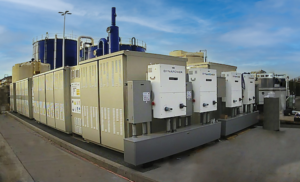
Image Courtesy of Redflow
Redflow is an Australian redox flow battery maker, meaning that its batteries work through a continual cycling of reduction and oxidation. Unlike solid state batteries, flow batteries literally flow an electrolyte between two tanks… back and forth. And flow battery tanks can be as large as two-story homes!
Unlike our colleagues at Invinity who manufacture vanadiun redox flow batteries, Redflow uses a zinc-bromine flow technology. They are designed for high-cycle rates, long-time base stationary energy storage applications, and they are scalable from small systems through grid-scale deployments. Unique advantages of these batteries include 100% daily depth of discharge and tolerance to high temperatures. Reportedly, they can thrive in tough conditions.
Redflow now plans a second United States project, its largest project. In partnership with the California-based biowaste technology firm Anaergia, it plans to couple solar with a 6 MWh battery energy storage solution. It has signed a letter of intent with Anaergia subsidiary’s, SoCal Biomethane, to install the flow batteries at its Victor Valley bioenergy plant which converts food waste and wastewater into natural gas. The solar + storage solution will reduce the plant’s operating costs, will cut its carbon footprint, and it is slated to be completed mid-2023.
The planned facility in Victor Valley comes on the heels of a 2 MWh storage project in Rialto, California. That consists of 12, 160 kWh “energy pods.” The 6 MWh installation in Victor Valley will use as many as 600 Redflow Generation 3 batteries.
End of Life Solar Modules
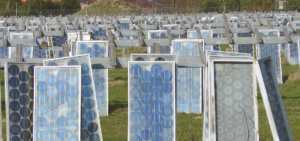
Image Courtesy of PV Cycle
The U.S. Department of Energy has released an action plan for the safe and responsible handling of photovoltaic (PV) end-of-life materials (EOL). It finds that while 95% of a module’s material is recyclable, the current economics of EOL PV module recycling is not favorable. Generally, it costs less to landfill a module than to recycle it. DOE notes that establishing safe, responsible, and economic EOL practices will support greater deployment, and the goal of decarbonizing the electricity grid by 2035.
There are millions of solar systems now deployed in the United states, meaning that there are hundreds of millions of PV panels in use. Most are young; 70% of all solar systems were installed in the last 5 years. Generally the systems will last 30 – 35 years although some consumers may elect to upgrade their solar panels before the EOL of their existing ones to reap greater generation. According to the International Renewable Energy Agency, cumulative end-of-life photovoltaic waste in the United States in 2030 is projected to be as much as 1 million tones. To put this in perspective, there are roughly 200 million tons of waste generated in the U.S. each year.
In related news, the world has now installed greater than 1 Terawatt of solar. The Earth’s solar capacity milestone reported by PV Magazine may be underestimated due to reporting and overestimated due to remodeling of homes and storms that destroy solar systems. The three major players – China, the European Union, and the United States – represent more than half of the world’s installed capacity. According to the BP Statistical Energy Review 2021, the world generated 26,823 TWh (or 26.8 Petawatt-hours) of electricity in 2020… of which 3.1% or 855 TWh were solar.
New Life for Turkish Coal Mines

Europe’s Beyond Coal campaign has produced a new report on the solar potential of coal sites in Turkey. Most are open-cast (open-pit) mines that are conducive to solar. If erected properly, the report states, one half of the country’s coal mines conversion to solar would increase solar in the country by 170% and would generate enough electricity to power nearly 7 million Turkish homes.
The Beyond Coal report finds that one quarter of Turkey’s GHG emissions are the result of using coal for power production. Mines can play a crucial role in decarbonizing. The plan would reduce the country’s CO2 emissions by more than 12.4 million tonnes per year. Attracting investors and going solar minimizes the economic impacts in the regions caused by closure of coal mines. Furthermore, the report states that counties with large, open-cast coal mines should be viewing them as renewable energy transition assets. They can have a cost advantage over virgin plots with much of the necessary infrastructure to host and interconnect solar already in place.
Pumped Hydro Storage

While lithium-ion batteries have stolen the energy storage show, while they’ve taken center spotlight, there are other forms of storage worthy of examination and application. As we pair intermittent renewables with storage to match our consumption patterns, we’ll need numerous cost-effective options.
Here are eight energy storage options. There are undoubtedly more. And within batteries, there are many chemistries being explored:
- Batteries
- Compressed air
- Pumped hydro storage
- Hydrogen
- Molten salts
- Iced and chilled water
- Seasonal thermal mass storage
- Gravitational storage
My favorites are not batteries, but gravitational systems and pumped hydro storage for their economics. Let’s focus on the latter:
Pacific Northwest National Laboratory found that in 2020 there were 43 pumped storage hydropower (PSH) facilities in the United States with 21 GW of capacity. One of them is owned by LADWP where I used to work. The Castaic system can deliver 1 GW of capacity for up to 5 hours. New York Power Authority’s PSH plant is of similar capacity. There are also PSH plants in places like Zimbabwe and Lithuania and Germany. PSH is a common and valuable addition to power systems. Naturally, it takes suitable topography to have an upper reservoir.
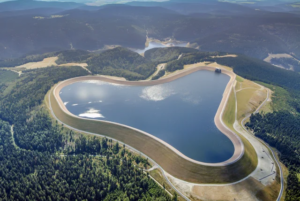
I’m surprised to learn about new developments for PSH, both “open-loop” and “closed-loop” systems, the latter located “off stream” meaning that closed-loop systems are not continually connected to a natural water source. Recently there have been numerous permits filed for closed-loop systems in the United States. They have less environmental impacts to aquatic and terrestrial habitats. On the other hand, if they rely on groundwater to replenish their reservoirs there is impact.
Australian former prime minister Malcolm Turnbull called PSH “the ultimate long duration energy storage solution” for his country. The Australian government has projected the need for 45 GW and 620 GWh of storage capacity/energy to shift from fossil fuels to renewables. The new 2 GW Snowy 2 pumped hydro project there builds on the existing 4.1 GW Snowy Mountain Scheme. Snowy 2 is a $4.6 billion project. It will link the Tantangara and Talbingo dams via 17 miles of tunnels. Its 350 GWh of stored energy represents seven and a half days of storage!
The Empire State Leads in Community Solar
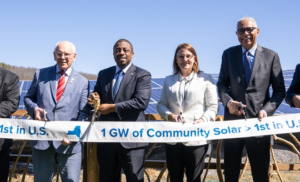
New York, the Empire State, has become the first state in the nation to surpass 1 GW of community solar installed. Announced by Governor Kathy Hochul, that’s enough power to serve 209,000 homes. New York States also has the largest pipeline of community solar, with enough under construction to serve an additional 401,000 homes.
The community solar accomplishments are part of the State’s progress with its Climate Act goal of generating 70% of the State’s electricity from renewables by 2030, and to achieve 10 GW of solar by 2030. With community solar, New York is making “clean energy history” ahead of second place Minnesota.
In terms of overall PV installations, Texas jumped ahead of California in 2021 with 6,060 installations in a single year. New York is in the top 10 states for cumulative solar installed — some 3,380 MW from 158,099 installations. New York also boasts the 32 MW Long Island Solar Farm located on the Brookhaven National Laboratory site which serves power to the Long Island Power Authority.
The NetPositive Podcast Updates

Recently Released:
Check out and subscribe to The NetPositive Podcast with Ted Flanigan on Spotify, Apple, and Google. Episodes include Convos (Conversations), Crash Courses with Sierra and Ted Flanigan), and the News (EcoNet News).
